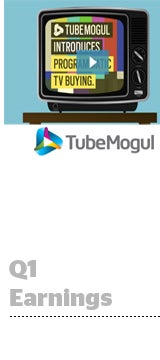 In the first quarter, TubeMogul’s self-serve software, called Platform Direct, accounted for 78% – or $55.3 million – of total advertiser spend running through the company.
In the first quarter, TubeMogul’s self-serve software, called Platform Direct, accounted for 78% – or $55.3 million – of total advertiser spend running through the company.
The video demand-side platform (DSP) has worked to migrate managed services clients onto its platform, which could garner the recurring revenue and customer-retention rates characteristic of enterprise software deployments.
Agencies accounted for 37% of Q1 spend on Platform Direct – a growing percentage as holding companies give individual agencies responsibility over programmatic, said TubeMogul CEO Brett Wilson. He noted, for instance, the decentralization at Publicis Groupe’s agency trading desk, VivaKi, when it was announced staff would be deployed to multiple agencies.
“Agency [reps] increasingly have their fingers on keyboards executing programmatic campaigns,” he said. “Every trading desk strategy is different … but the technology of programmatic has been ahead of [standard agency] models for some time and brands are demanding more transparency.”
Wilson expects this shift at the agency level to be a boon for TubeMogul, which recently inked video advertising deals with Hill Holliday, Essence Digital and Wasserman + Partners.
Last quarter, TubeMogul launched a module that lets clients manage their own margins and support fees. The tool’s “extensive reporting features” let clients track TubeMogul platform fees, in addition to incurred media and data costs from other providers.
“We think this module addresses major need of agencies who are taking on programmatic buying for clients, but who need more efficiency in their [margin] forecasting,” Wilson said.
TubeMogul also revealed it’s working with IPG Mediabrands to develop a custom advanced TV buying platform for the latter’s marketing services platform Cadreon. The platform is running beta campaigns, and a full release is planned this summer.
BMO Capital Markets analyst Dan Salmon asked whether similar agency holding company deals might develop.
Wilson said each advertiser and each agency uses the platform differently, and that Cadreon’s TV platform is highly customized, incorporating unique data sets, and will only be available to IPG clients. By contrast, TubeMogul’s standard programmatic TV (PTV) platform is available to all advertisers.
Mobile video is another growth area for TubeMogul, with mobile increasing to 12% of spend globally this quarter.
“The story of the quarter was cross-screen with the Cadreon partnership for programmatic TV,” Wilson told AdExchanger. “More generally, we saw an acceleration of [programmatic TV] PTV demand within the quarter.” TubeMogul also integrated with a digital out-of-home exchange enabling advertisers in Australia to buy through its software billboards and kiosk inventory programmatically.
Mobile video is hot (so hot that Verizon is dropping $4.4 billion on AOL), but according to results from a report Google released last Friday, it’s clear marketers are still trying to wrap their heads around viewability in video on desktop, let alone mobile video.
In the report, Google, based on analysis of hundreds of billions of impressions served through its own networks, found only 54% of standard web ads are viewable compared to YouTube’s 91%.
Non-YouTube mobile video inventory was not factored in, since Google lacked the SDK integrations needed to measure it. Industry insiders, however, said the report was biased, since YouTube videos are by default served in a native video environment with a large player, not distributed across the web. In other words, they naturally have a better chance to be seen.
Wilson said Google’s findings were “interesting,” given it doesn’t allow third-party measurement and you’re essentially “taking their word for it” with viewability results.
“Marketers are aware most of their audiences are increasingly mobile and as they become aware of trade-offs between media types, [the viewability conversation] could accelerate interest in formats in mobile or connected devices that are inherently viewable,” he said. “Right now there’s no on mobile viewability measurement standard, but clearly that will accelerate growth when it happens.”
TubeMogul total advertiser spend in Q1 was $71.3 million, an increase of 48% year over year. Revenue was $30.3 million, a 38% increase YOY compared to $22 million in the first quarter of 2014.













